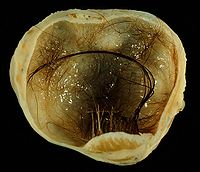
Photo from wikipedia
The spectrum of diagnoses of uterine mesenchymal tumours is continuously evolving. Until recently, these neoplasms were classified either as smooth muscle or as endometrial stromal neoplasms. The smooth muscle neoplasms… Click to show full abstract
The spectrum of diagnoses of uterine mesenchymal tumours is continuously evolving. Until recently, these neoplasms were classified either as smooth muscle or as endometrial stromal neoplasms. The smooth muscle neoplasms were categorised as benign, malignant or smoothmuscle tumours of uncertainmalignant potential.With increasing sophistication of diagnosis and use of molecular techniques, there has been an expansion in the classification of tumour types and the distinction between these categories is becoming more refined. The diagnosis of uterine smoothmuscle tumours (USMTs) is, inmost cases, straightforward. Most uterine smooth muscle tumours are benign. Leiomyosarcomas are diagnosed when a triad of histopathological features is seen significant atypia, increased mitotic activity and coagulative/ tumour cell necrosis. However, USMTs can show a range of morphological and biological diversity and with the recognition that there are USMTs that defy a binary classification of diagnostic categories, the term smooth muscle tumour of uncertain malignant potential (STUMP) was introduced. This was done on the basis of a seminal paper [1] and has since been incorporated into the WHO classification. The 2014WHO classification [2] defines STUMP as ‘a smoothmuscle tumour with features that preclude an unequivocal diagnosis of leiomyosarcoma, but does not fulfil the criteria for leiomyoma, or its variants, and raises concern that the neoplasm may behave in a malignant fashion’. There have been several studies of STUMP looking at predictors of behaviour within this subgroup. These include immunohistochemistry with PHH3, p53, PR, Ki67, Bcl-2 and alphaSMA [3–5]. Whilst some of these markers have shown statistical significance in studies of case series when compared with leiomyomas or leiomyosarcomas, none has proved robust enough to incorporate into routine practice in the diagnosis of an individual case. It has been proposed that expansion of the histological criteria for STUMPs to include atypical mitoses, epithelioid differentiation, vascular involvement and infiltrative/irregular margins will allow better identification of the
Journal Title: Case Reports in Women's Health
Year Published: 2020
Link to full text (if available)
Share on Social Media: Sign Up to like & get
recommendations!